Business Data Analysis and Interpretation for JCU Staff
VerifiedAdded on 2020/05/28
|16
|1743
|156
Report
AI Summary
This report presents a comprehensive analysis of data related to staff at James Cook University (JCU), focusing on key aspects such as salary, length of employment, gender distribution across different campuses, and educational levels. The analysis includes descriptive statistics, correlation analyses, and graphical representations like box plots, bar charts, and contingency tables to visualize and interpret the data effectively. Key findings reveal the average annual salary, the relationship between length of employment and salary, and the distribution of salaries across different genders and campuses. The report also examines the educational levels of the staff and their distribution across campuses. The study aims to provide insights relevant to the Vice Chancellor's interest in fostering a gender-neutral workplace and understanding the university's carbon footprint. The report utilizes various statistical techniques to identify patterns and trends within the dataset, offering valuable information for decision-making and policy development at JCU.
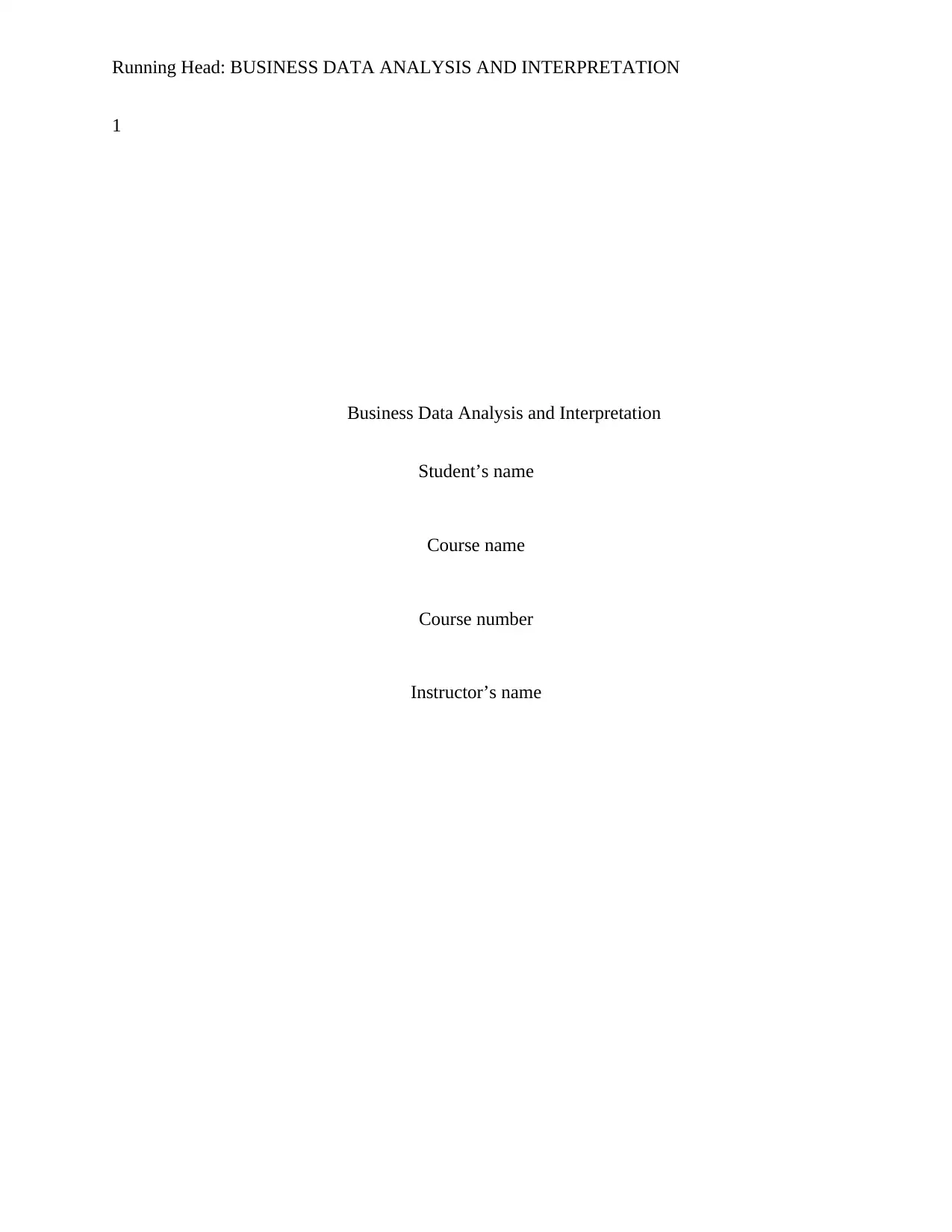
Running Head: BUSINESS DATA ANALYSIS AND INTERPRETATION
1
Business Data Analysis and Interpretation
Student’s name
Course name
Course number
Instructor’s name
1
Business Data Analysis and Interpretation
Student’s name
Course name
Course number
Instructor’s name
Paraphrase This Document
Need a fresh take? Get an instant paraphrase of this document with our AI Paraphraser
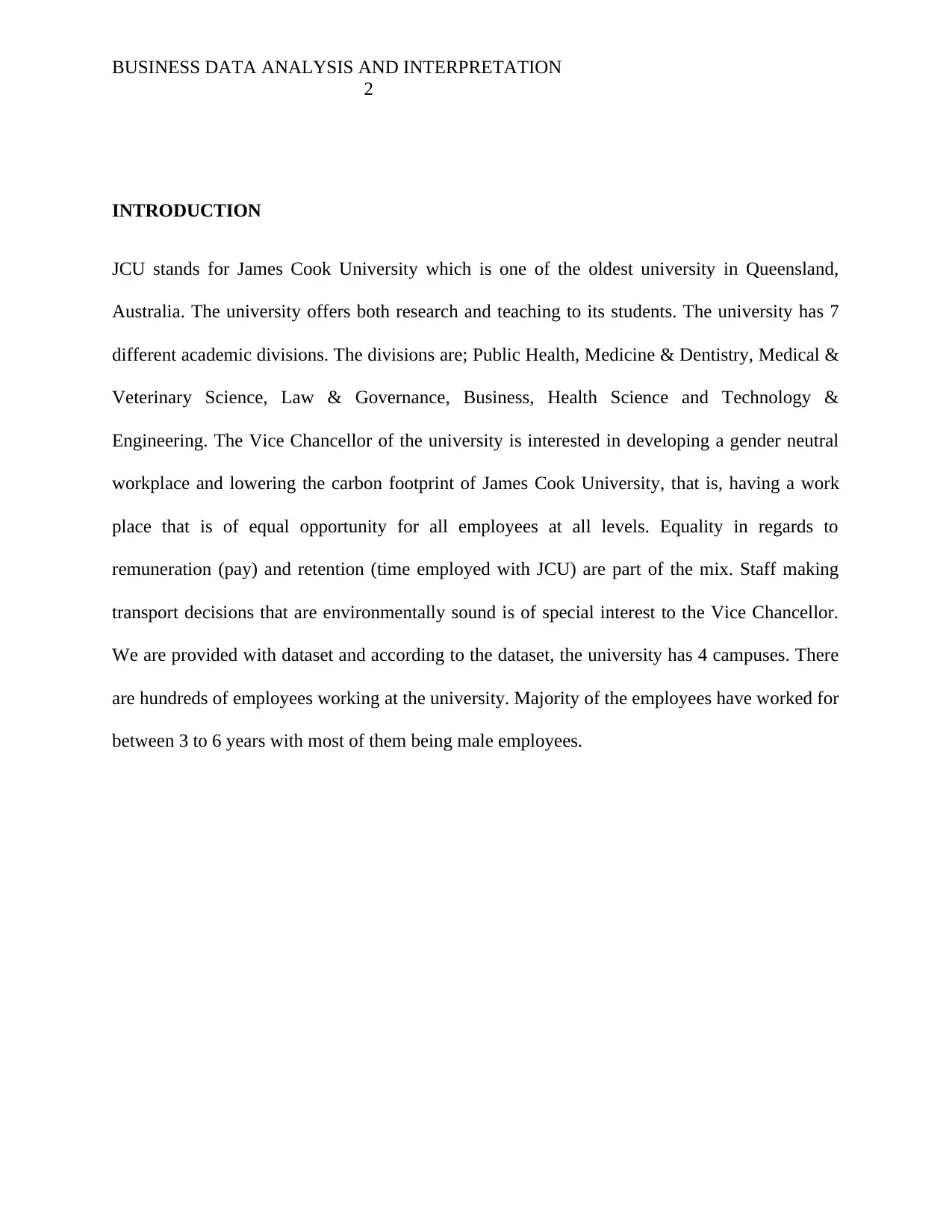
BUSINESS DATA ANALYSIS AND INTERPRETATION
2
INTRODUCTION
JCU stands for James Cook University which is one of the oldest university in Queensland,
Australia. The university offers both research and teaching to its students. The university has 7
different academic divisions. The divisions are; Public Health, Medicine & Dentistry, Medical &
Veterinary Science, Law & Governance, Business, Health Science and Technology &
Engineering. The Vice Chancellor of the university is interested in developing a gender neutral
workplace and lowering the carbon footprint of James Cook University, that is, having a work
place that is of equal opportunity for all employees at all levels. Equality in regards to
remuneration (pay) and retention (time employed with JCU) are part of the mix. Staff making
transport decisions that are environmentally sound is of special interest to the Vice Chancellor.
We are provided with dataset and according to the dataset, the university has 4 campuses. There
are hundreds of employees working at the university. Majority of the employees have worked for
between 3 to 6 years with most of them being male employees.
2
INTRODUCTION
JCU stands for James Cook University which is one of the oldest university in Queensland,
Australia. The university offers both research and teaching to its students. The university has 7
different academic divisions. The divisions are; Public Health, Medicine & Dentistry, Medical &
Veterinary Science, Law & Governance, Business, Health Science and Technology &
Engineering. The Vice Chancellor of the university is interested in developing a gender neutral
workplace and lowering the carbon footprint of James Cook University, that is, having a work
place that is of equal opportunity for all employees at all levels. Equality in regards to
remuneration (pay) and retention (time employed with JCU) are part of the mix. Staff making
transport decisions that are environmentally sound is of special interest to the Vice Chancellor.
We are provided with dataset and according to the dataset, the university has 4 campuses. There
are hundreds of employees working at the university. Majority of the employees have worked for
between 3 to 6 years with most of them being male employees.
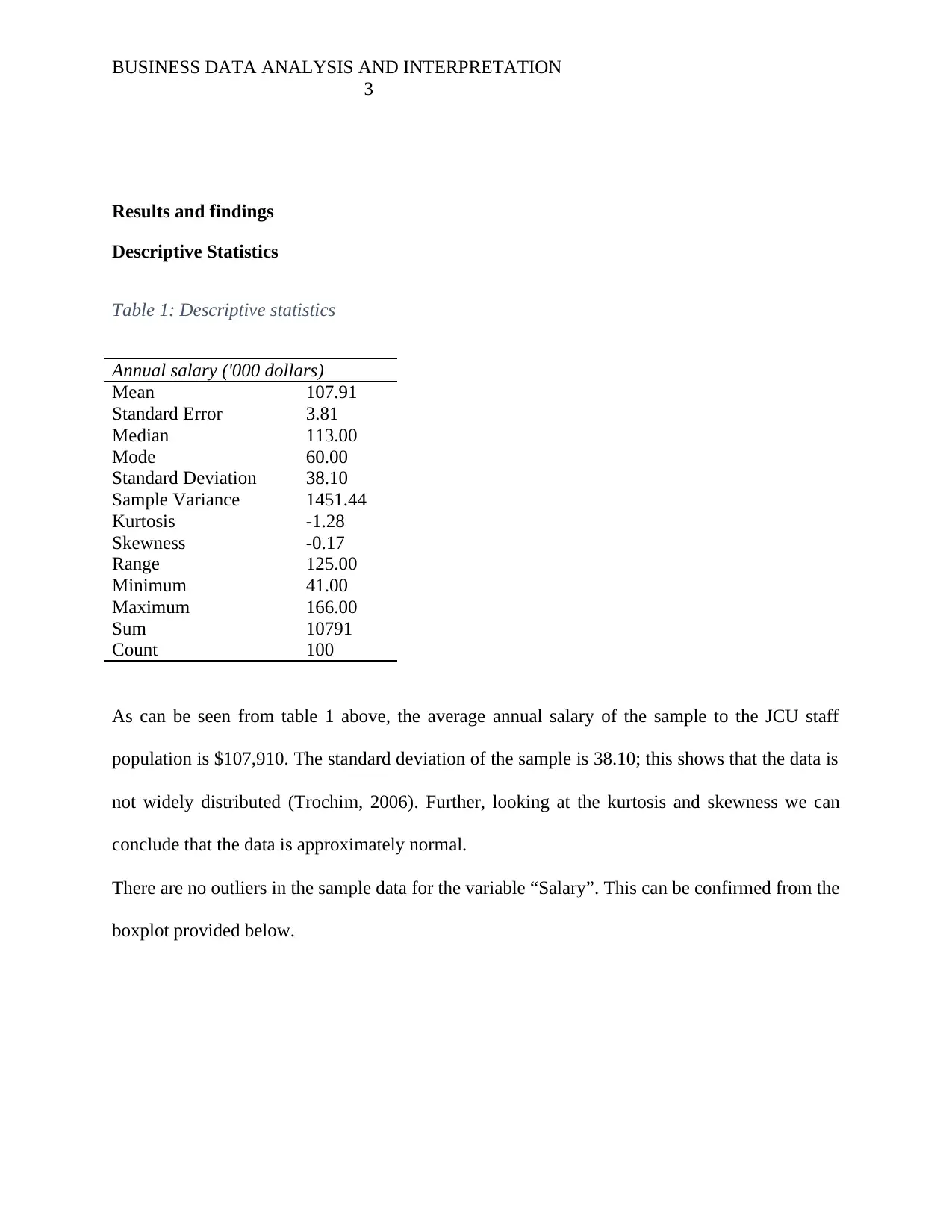
BUSINESS DATA ANALYSIS AND INTERPRETATION
3
Results and findings
Descriptive Statistics
Table 1: Descriptive statistics
Annual salary ('000 dollars)
Mean 107.91
Standard Error 3.81
Median 113.00
Mode 60.00
Standard Deviation 38.10
Sample Variance 1451.44
Kurtosis -1.28
Skewness -0.17
Range 125.00
Minimum 41.00
Maximum 166.00
Sum 10791
Count 100
As can be seen from table 1 above, the average annual salary of the sample to the JCU staff
population is $107,910. The standard deviation of the sample is 38.10; this shows that the data is
not widely distributed (Trochim, 2006). Further, looking at the kurtosis and skewness we can
conclude that the data is approximately normal.
There are no outliers in the sample data for the variable “Salary”. This can be confirmed from the
boxplot provided below.
3
Results and findings
Descriptive Statistics
Table 1: Descriptive statistics
Annual salary ('000 dollars)
Mean 107.91
Standard Error 3.81
Median 113.00
Mode 60.00
Standard Deviation 38.10
Sample Variance 1451.44
Kurtosis -1.28
Skewness -0.17
Range 125.00
Minimum 41.00
Maximum 166.00
Sum 10791
Count 100
As can be seen from table 1 above, the average annual salary of the sample to the JCU staff
population is $107,910. The standard deviation of the sample is 38.10; this shows that the data is
not widely distributed (Trochim, 2006). Further, looking at the kurtosis and skewness we can
conclude that the data is approximately normal.
There are no outliers in the sample data for the variable “Salary”. This can be confirmed from the
boxplot provided below.
⊘ This is a preview!⊘
Do you want full access?
Subscribe today to unlock all pages.

Trusted by 1+ million students worldwide
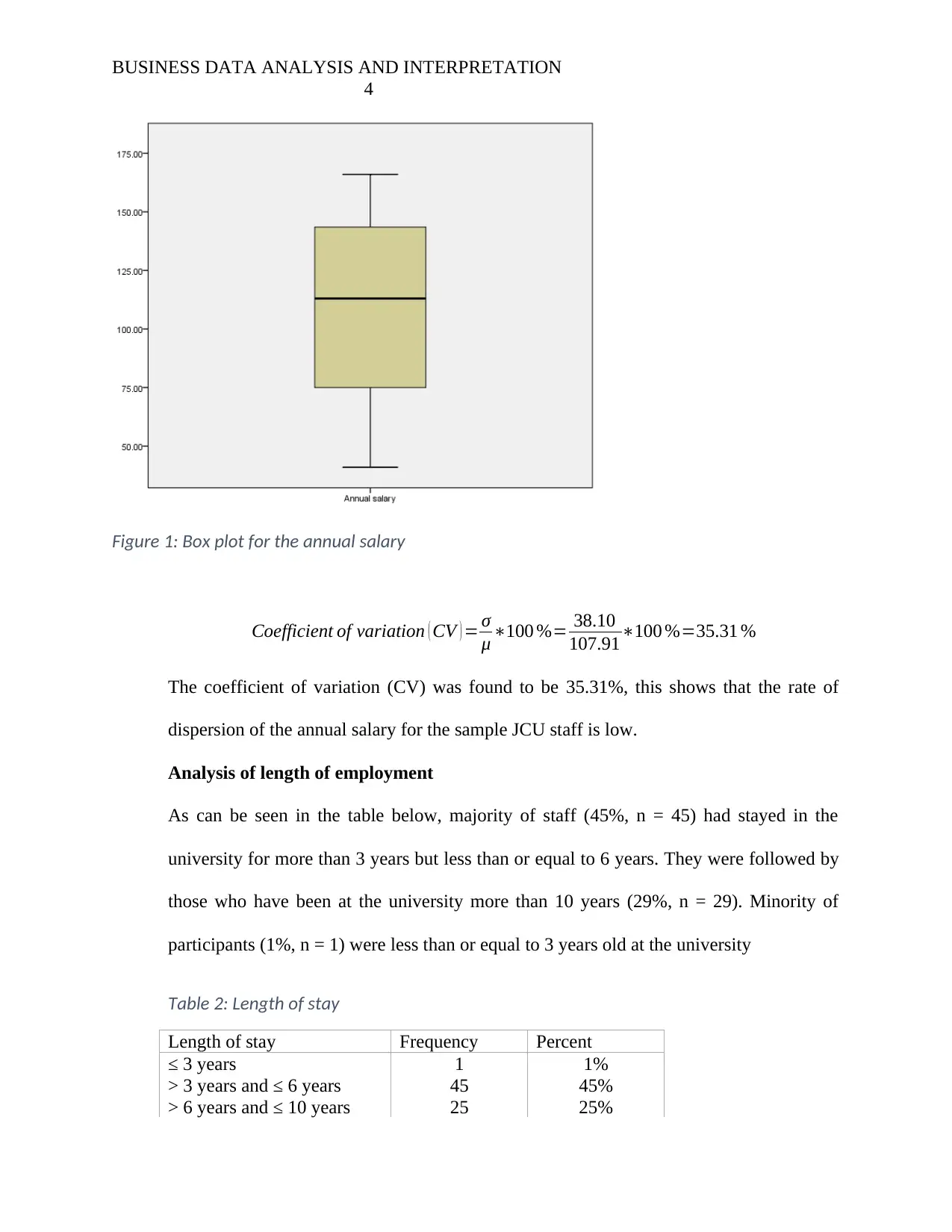
BUSINESS DATA ANALYSIS AND INTERPRETATION
4
Figure 1: Box plot for the annual salary
Coefficient of variation ( CV ) = σ
μ ∗100 %= 38.10
107.91∗100 %=35.31 %
The coefficient of variation (CV) was found to be 35.31%, this shows that the rate of
dispersion of the annual salary for the sample JCU staff is low.
Analysis of length of employment
As can be seen in the table below, majority of staff (45%, n = 45) had stayed in the
university for more than 3 years but less than or equal to 6 years. They were followed by
those who have been at the university more than 10 years (29%, n = 29). Minority of
participants (1%, n = 1) were less than or equal to 3 years old at the university
Table 2: Length of stay
Length of stay Frequency Percent
≤ 3 years 1 1%
> 3 years and ≤ 6 years 45 45%
> 6 years and ≤ 10 years 25 25%
4
Figure 1: Box plot for the annual salary
Coefficient of variation ( CV ) = σ
μ ∗100 %= 38.10
107.91∗100 %=35.31 %
The coefficient of variation (CV) was found to be 35.31%, this shows that the rate of
dispersion of the annual salary for the sample JCU staff is low.
Analysis of length of employment
As can be seen in the table below, majority of staff (45%, n = 45) had stayed in the
university for more than 3 years but less than or equal to 6 years. They were followed by
those who have been at the university more than 10 years (29%, n = 29). Minority of
participants (1%, n = 1) were less than or equal to 3 years old at the university
Table 2: Length of stay
Length of stay Frequency Percent
≤ 3 years 1 1%
> 3 years and ≤ 6 years 45 45%
> 6 years and ≤ 10 years 25 25%
Paraphrase This Document
Need a fresh take? Get an instant paraphrase of this document with our AI Paraphraser
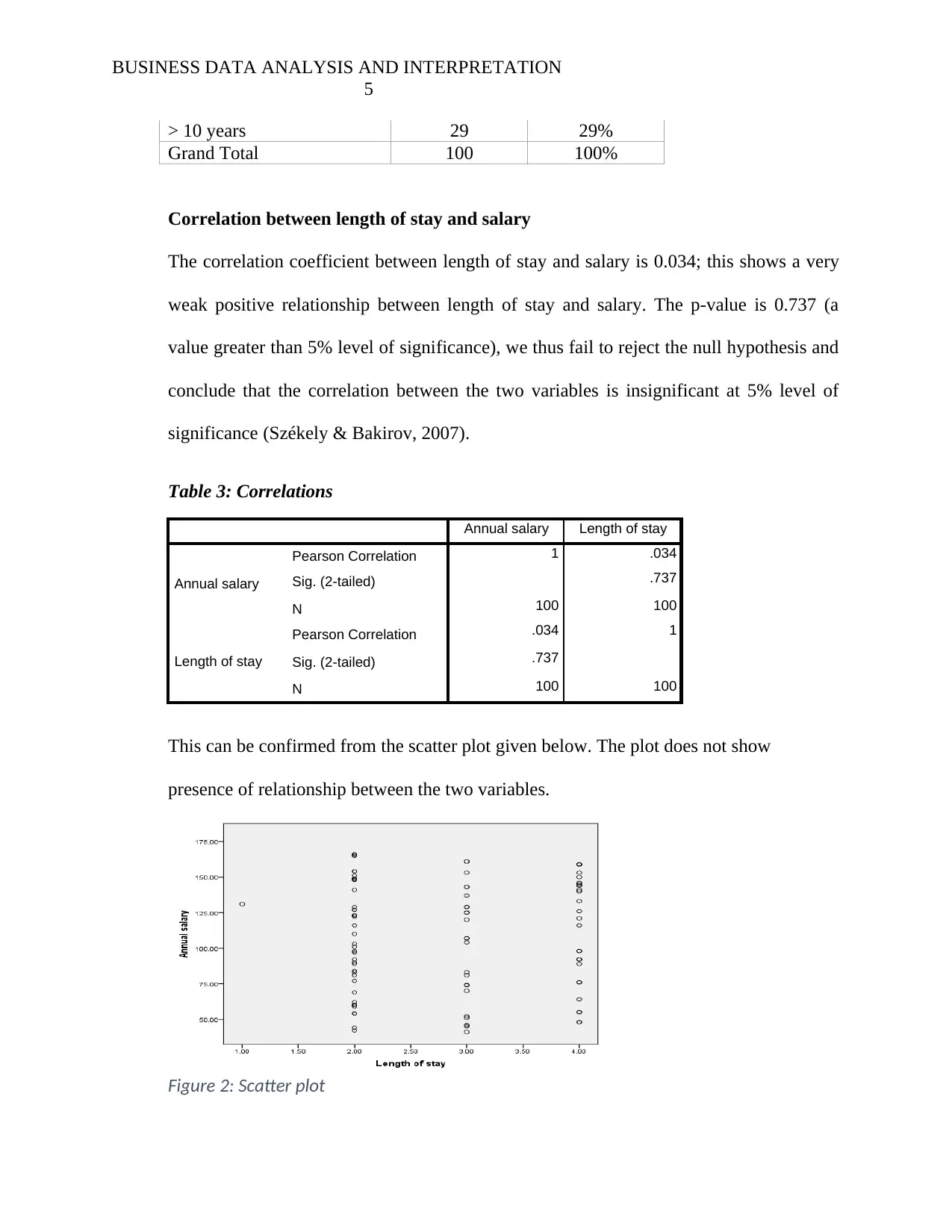
BUSINESS DATA ANALYSIS AND INTERPRETATION
5
> 10 years 29 29%
Grand Total 100 100%
Correlation between length of stay and salary
The correlation coefficient between length of stay and salary is 0.034; this shows a very
weak positive relationship between length of stay and salary. The p-value is 0.737 (a
value greater than 5% level of significance), we thus fail to reject the null hypothesis and
conclude that the correlation between the two variables is insignificant at 5% level of
significance (Székely & Bakirov, 2007).
Table 3: Correlations
Annual salary Length of stay
Annual salary
Pearson Correlation 1 .034
Sig. (2-tailed) .737
N 100 100
Length of stay
Pearson Correlation .034 1
Sig. (2-tailed) .737
N 100 100
This can be confirmed from the scatter plot given below. The plot does not show
presence of relationship between the two variables.
Figure 2: Scatter plot
5
> 10 years 29 29%
Grand Total 100 100%
Correlation between length of stay and salary
The correlation coefficient between length of stay and salary is 0.034; this shows a very
weak positive relationship between length of stay and salary. The p-value is 0.737 (a
value greater than 5% level of significance), we thus fail to reject the null hypothesis and
conclude that the correlation between the two variables is insignificant at 5% level of
significance (Székely & Bakirov, 2007).
Table 3: Correlations
Annual salary Length of stay
Annual salary
Pearson Correlation 1 .034
Sig. (2-tailed) .737
N 100 100
Length of stay
Pearson Correlation .034 1
Sig. (2-tailed) .737
N 100 100
This can be confirmed from the scatter plot given below. The plot does not show
presence of relationship between the two variables.
Figure 2: Scatter plot
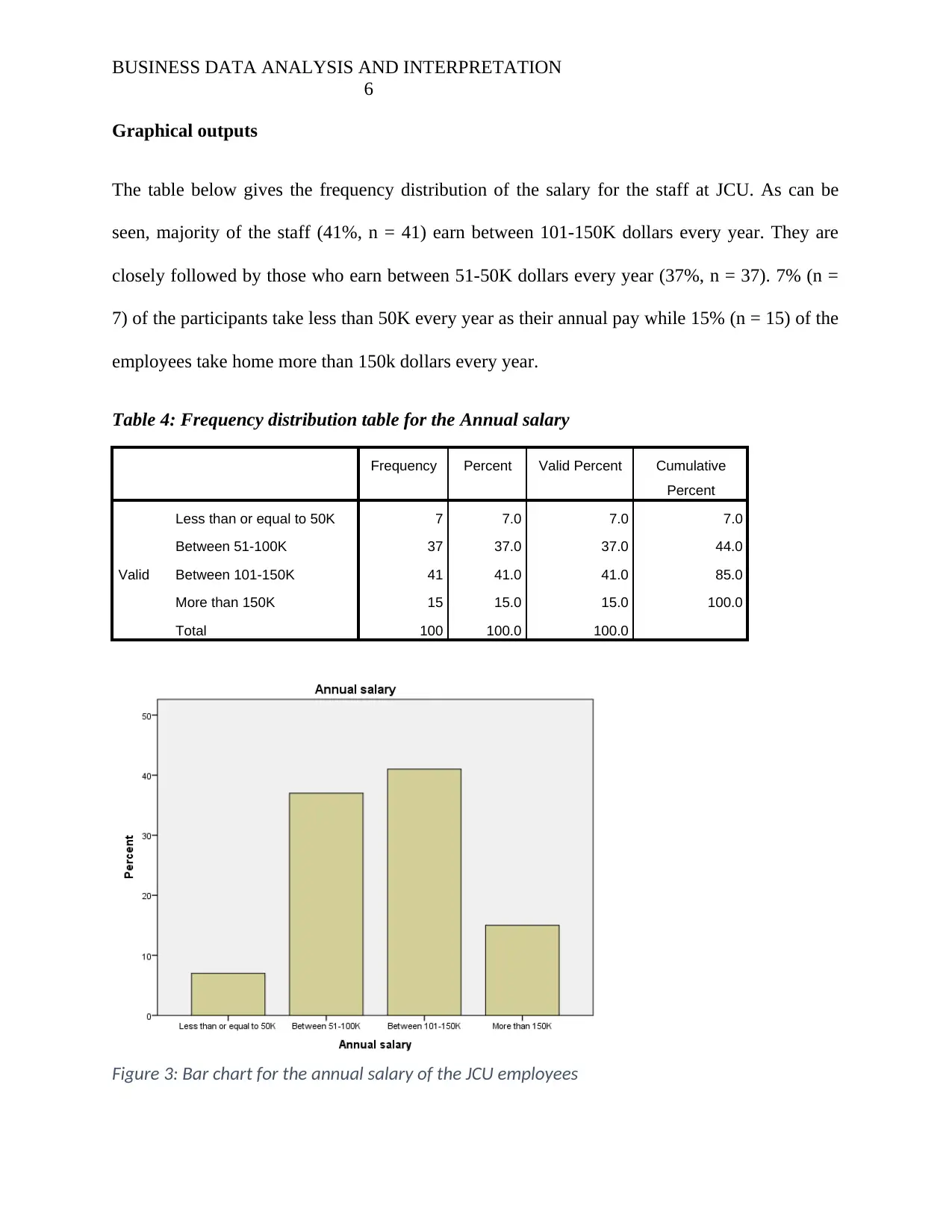
BUSINESS DATA ANALYSIS AND INTERPRETATION
6
Graphical outputs
The table below gives the frequency distribution of the salary for the staff at JCU. As can be
seen, majority of the staff (41%, n = 41) earn between 101-150K dollars every year. They are
closely followed by those who earn between 51-50K dollars every year (37%, n = 37). 7% (n =
7) of the participants take less than 50K every year as their annual pay while 15% (n = 15) of the
employees take home more than 150k dollars every year.
Table 4: Frequency distribution table for the Annual salary
Frequency Percent Valid Percent Cumulative
Percent
Valid
Less than or equal to 50K 7 7.0 7.0 7.0
Between 51-100K 37 37.0 37.0 44.0
Between 101-150K 41 41.0 41.0 85.0
More than 150K 15 15.0 15.0 100.0
Total 100 100.0 100.0
Figure 3: Bar chart for the annual salary of the JCU employees
6
Graphical outputs
The table below gives the frequency distribution of the salary for the staff at JCU. As can be
seen, majority of the staff (41%, n = 41) earn between 101-150K dollars every year. They are
closely followed by those who earn between 51-50K dollars every year (37%, n = 37). 7% (n =
7) of the participants take less than 50K every year as their annual pay while 15% (n = 15) of the
employees take home more than 150k dollars every year.
Table 4: Frequency distribution table for the Annual salary
Frequency Percent Valid Percent Cumulative
Percent
Valid
Less than or equal to 50K 7 7.0 7.0 7.0
Between 51-100K 37 37.0 37.0 44.0
Between 101-150K 41 41.0 41.0 85.0
More than 150K 15 15.0 15.0 100.0
Total 100 100.0 100.0
Figure 3: Bar chart for the annual salary of the JCU employees
⊘ This is a preview!⊘
Do you want full access?
Subscribe today to unlock all pages.

Trusted by 1+ million students worldwide
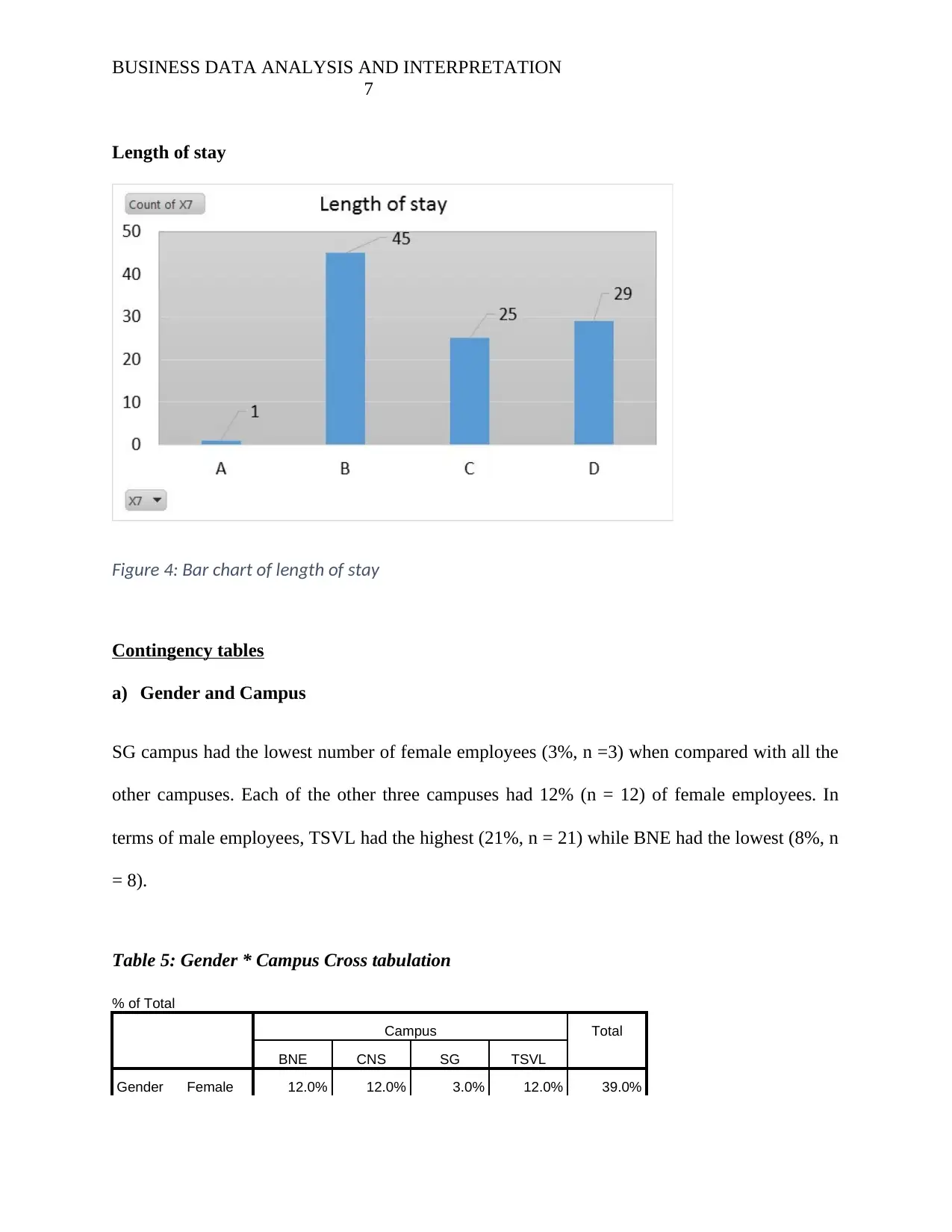
BUSINESS DATA ANALYSIS AND INTERPRETATION
7
Length of stay
Figure 4: Bar chart of length of stay
Contingency tables
a) Gender and Campus
SG campus had the lowest number of female employees (3%, n =3) when compared with all the
other campuses. Each of the other three campuses had 12% (n = 12) of female employees. In
terms of male employees, TSVL had the highest (21%, n = 21) while BNE had the lowest (8%, n
= 8).
Table 5: Gender * Campus Cross tabulation
% of Total
Campus Total
BNE CNS SG TSVL
Gender Female 12.0% 12.0% 3.0% 12.0% 39.0%
7
Length of stay
Figure 4: Bar chart of length of stay
Contingency tables
a) Gender and Campus
SG campus had the lowest number of female employees (3%, n =3) when compared with all the
other campuses. Each of the other three campuses had 12% (n = 12) of female employees. In
terms of male employees, TSVL had the highest (21%, n = 21) while BNE had the lowest (8%, n
= 8).
Table 5: Gender * Campus Cross tabulation
% of Total
Campus Total
BNE CNS SG TSVL
Gender Female 12.0% 12.0% 3.0% 12.0% 39.0%
Paraphrase This Document
Need a fresh take? Get an instant paraphrase of this document with our AI Paraphraser
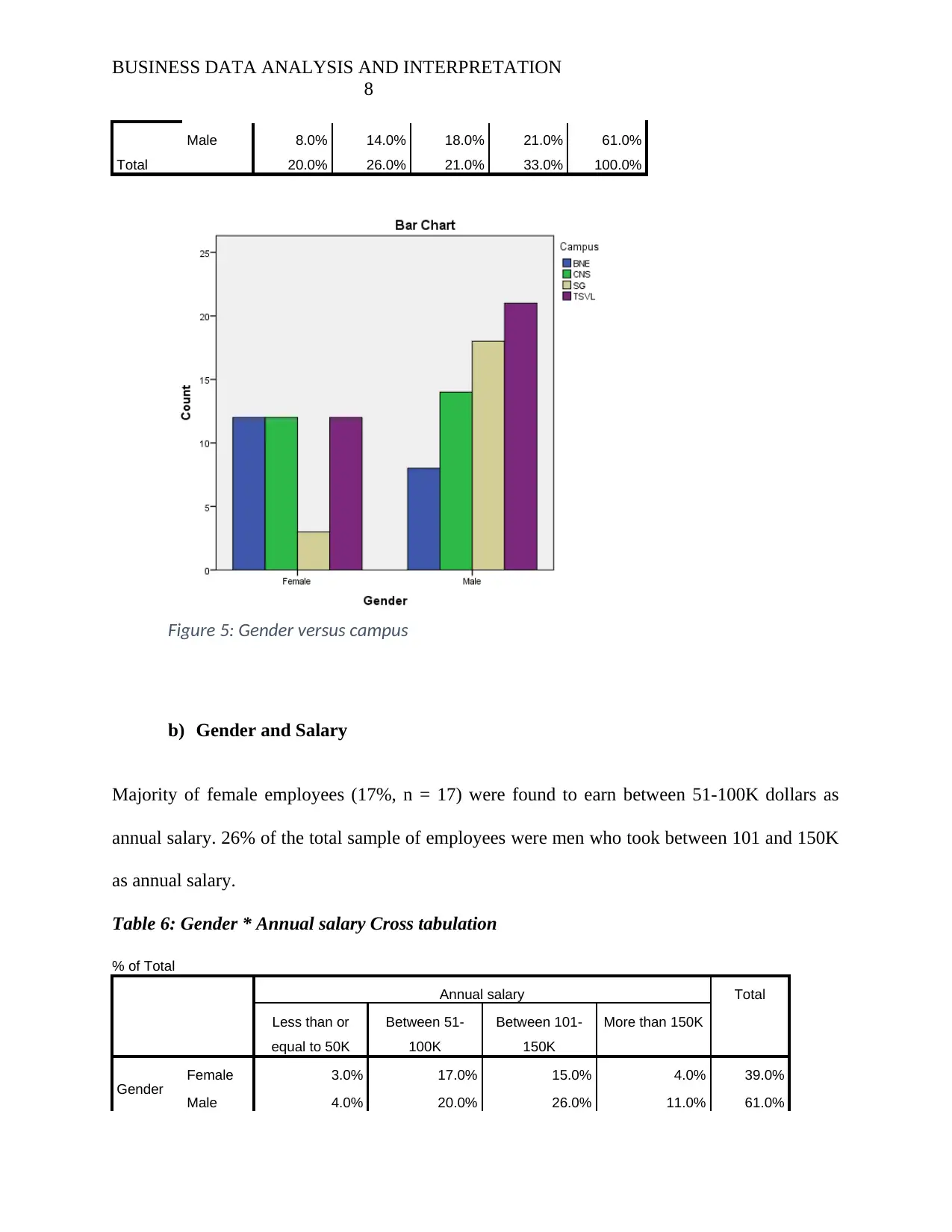
BUSINESS DATA ANALYSIS AND INTERPRETATION
8
Male 8.0% 14.0% 18.0% 21.0% 61.0%
Total 20.0% 26.0% 21.0% 33.0% 100.0%
Figure 5: Gender versus campus
b) Gender and Salary
Majority of female employees (17%, n = 17) were found to earn between 51-100K dollars as
annual salary. 26% of the total sample of employees were men who took between 101 and 150K
as annual salary.
Table 6: Gender * Annual salary Cross tabulation
% of Total
Annual salary Total
Less than or
equal to 50K
Between 51-
100K
Between 101-
150K
More than 150K
Gender Female 3.0% 17.0% 15.0% 4.0% 39.0%
Male 4.0% 20.0% 26.0% 11.0% 61.0%
8
Male 8.0% 14.0% 18.0% 21.0% 61.0%
Total 20.0% 26.0% 21.0% 33.0% 100.0%
Figure 5: Gender versus campus
b) Gender and Salary
Majority of female employees (17%, n = 17) were found to earn between 51-100K dollars as
annual salary. 26% of the total sample of employees were men who took between 101 and 150K
as annual salary.
Table 6: Gender * Annual salary Cross tabulation
% of Total
Annual salary Total
Less than or
equal to 50K
Between 51-
100K
Between 101-
150K
More than 150K
Gender Female 3.0% 17.0% 15.0% 4.0% 39.0%
Male 4.0% 20.0% 26.0% 11.0% 61.0%
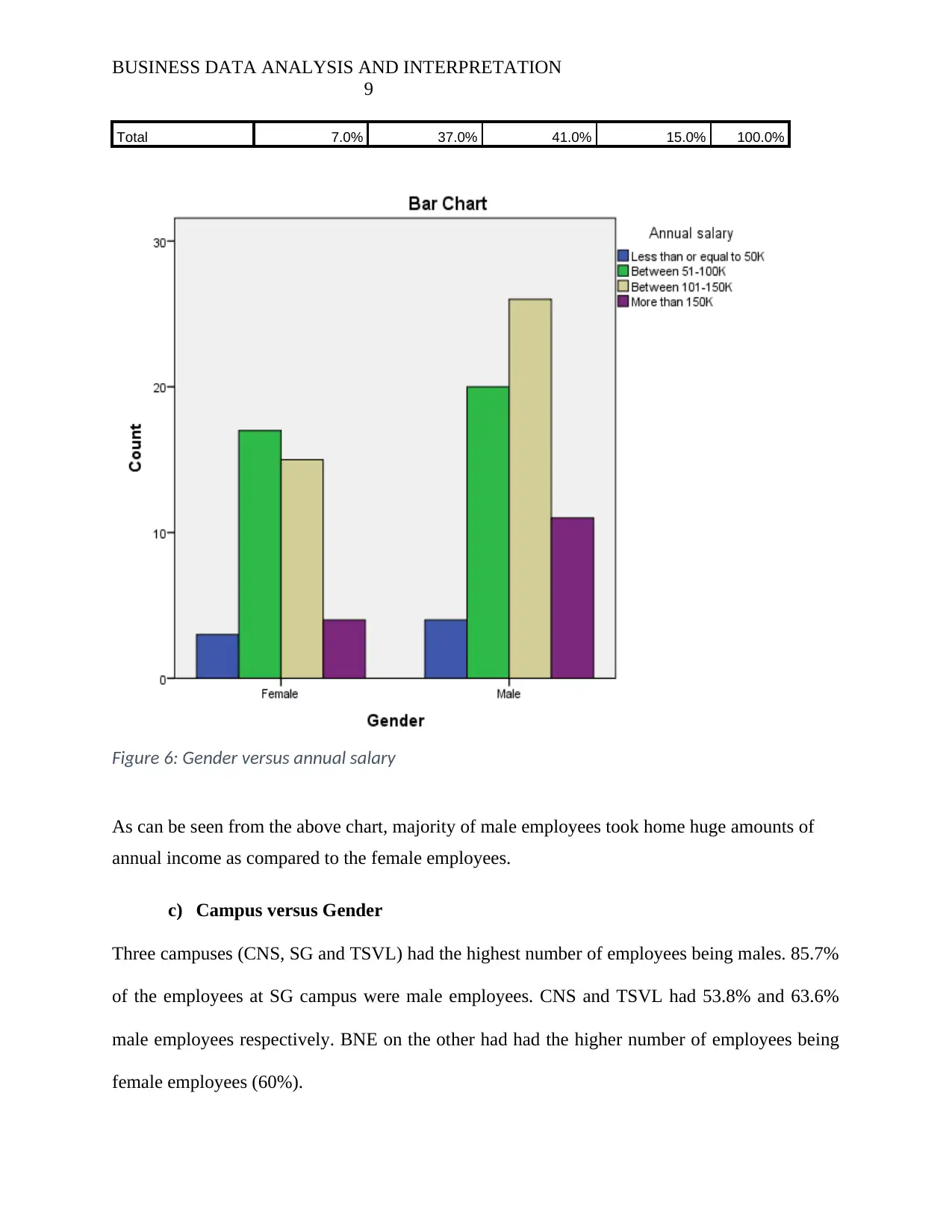
BUSINESS DATA ANALYSIS AND INTERPRETATION
9
Total 7.0% 37.0% 41.0% 15.0% 100.0%
Figure 6: Gender versus annual salary
As can be seen from the above chart, majority of male employees took home huge amounts of
annual income as compared to the female employees.
c) Campus versus Gender
Three campuses (CNS, SG and TSVL) had the highest number of employees being males. 85.7%
of the employees at SG campus were male employees. CNS and TSVL had 53.8% and 63.6%
male employees respectively. BNE on the other had had the higher number of employees being
female employees (60%).
9
Total 7.0% 37.0% 41.0% 15.0% 100.0%
Figure 6: Gender versus annual salary
As can be seen from the above chart, majority of male employees took home huge amounts of
annual income as compared to the female employees.
c) Campus versus Gender
Three campuses (CNS, SG and TSVL) had the highest number of employees being males. 85.7%
of the employees at SG campus were male employees. CNS and TSVL had 53.8% and 63.6%
male employees respectively. BNE on the other had had the higher number of employees being
female employees (60%).
⊘ This is a preview!⊘
Do you want full access?
Subscribe today to unlock all pages.

Trusted by 1+ million students worldwide
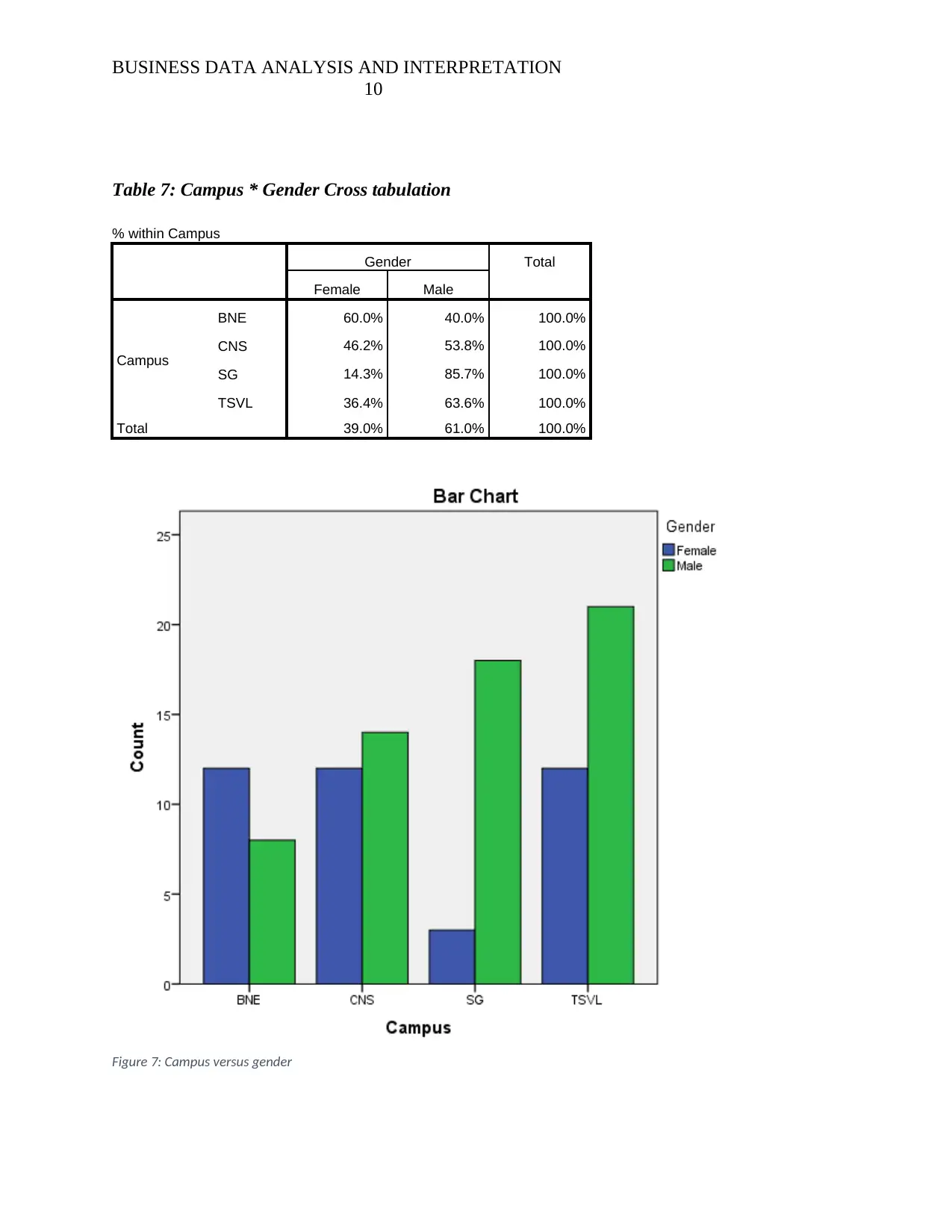
BUSINESS DATA ANALYSIS AND INTERPRETATION
10
Table 7: Campus * Gender Cross tabulation
% within Campus
Gender Total
Female Male
Campus
BNE 60.0% 40.0% 100.0%
CNS 46.2% 53.8% 100.0%
SG 14.3% 85.7% 100.0%
TSVL 36.4% 63.6% 100.0%
Total 39.0% 61.0% 100.0%
Figure 7: Campus versus gender
10
Table 7: Campus * Gender Cross tabulation
% within Campus
Gender Total
Female Male
Campus
BNE 60.0% 40.0% 100.0%
CNS 46.2% 53.8% 100.0%
SG 14.3% 85.7% 100.0%
TSVL 36.4% 63.6% 100.0%
Total 39.0% 61.0% 100.0%
Figure 7: Campus versus gender
Paraphrase This Document
Need a fresh take? Get an instant paraphrase of this document with our AI Paraphraser
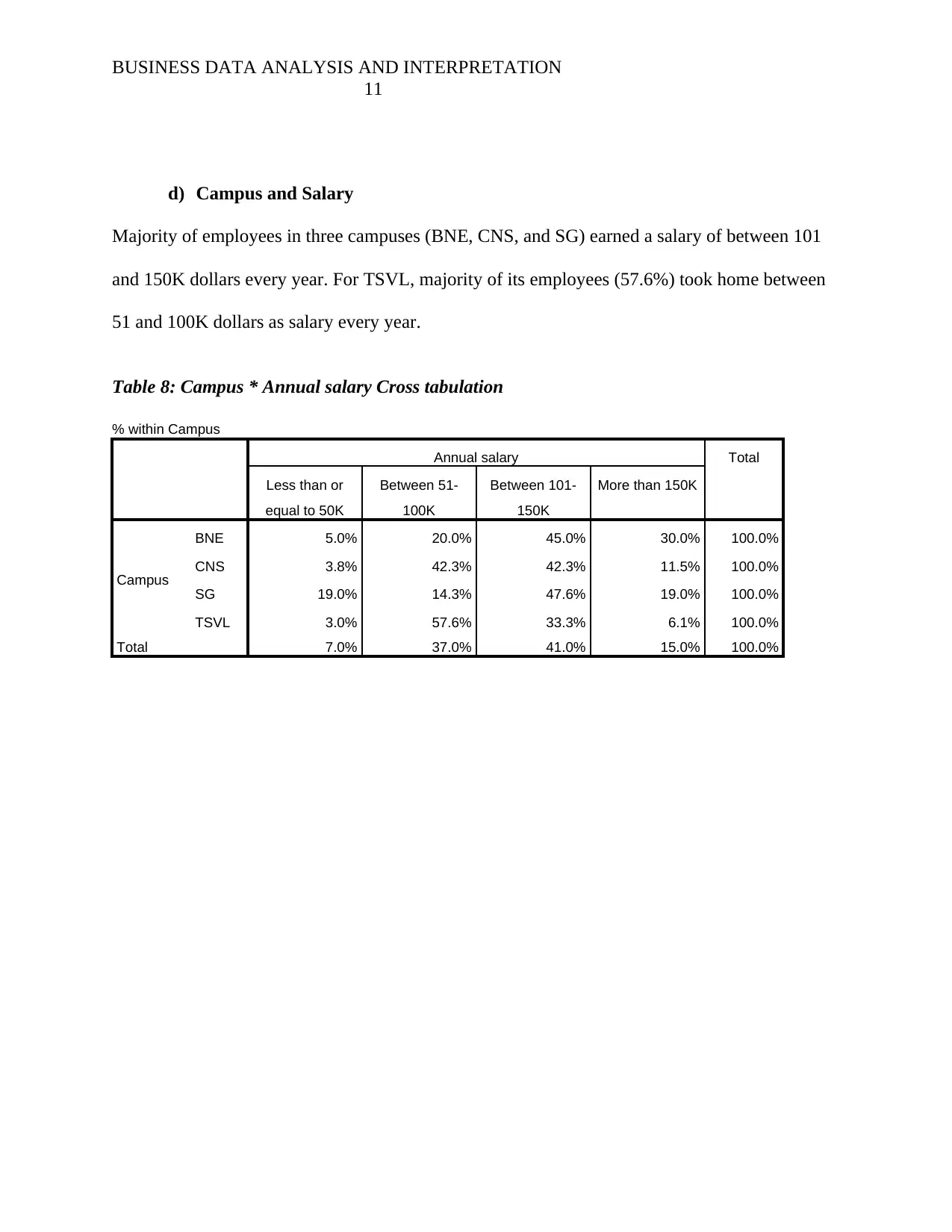
BUSINESS DATA ANALYSIS AND INTERPRETATION
11
d) Campus and Salary
Majority of employees in three campuses (BNE, CNS, and SG) earned a salary of between 101
and 150K dollars every year. For TSVL, majority of its employees (57.6%) took home between
51 and 100K dollars as salary every year.
Table 8: Campus * Annual salary Cross tabulation
% within Campus
Annual salary Total
Less than or
equal to 50K
Between 51-
100K
Between 101-
150K
More than 150K
Campus
BNE 5.0% 20.0% 45.0% 30.0% 100.0%
CNS 3.8% 42.3% 42.3% 11.5% 100.0%
SG 19.0% 14.3% 47.6% 19.0% 100.0%
TSVL 3.0% 57.6% 33.3% 6.1% 100.0%
Total 7.0% 37.0% 41.0% 15.0% 100.0%
11
d) Campus and Salary
Majority of employees in three campuses (BNE, CNS, and SG) earned a salary of between 101
and 150K dollars every year. For TSVL, majority of its employees (57.6%) took home between
51 and 100K dollars as salary every year.
Table 8: Campus * Annual salary Cross tabulation
% within Campus
Annual salary Total
Less than or
equal to 50K
Between 51-
100K
Between 101-
150K
More than 150K
Campus
BNE 5.0% 20.0% 45.0% 30.0% 100.0%
CNS 3.8% 42.3% 42.3% 11.5% 100.0%
SG 19.0% 14.3% 47.6% 19.0% 100.0%
TSVL 3.0% 57.6% 33.3% 6.1% 100.0%
Total 7.0% 37.0% 41.0% 15.0% 100.0%
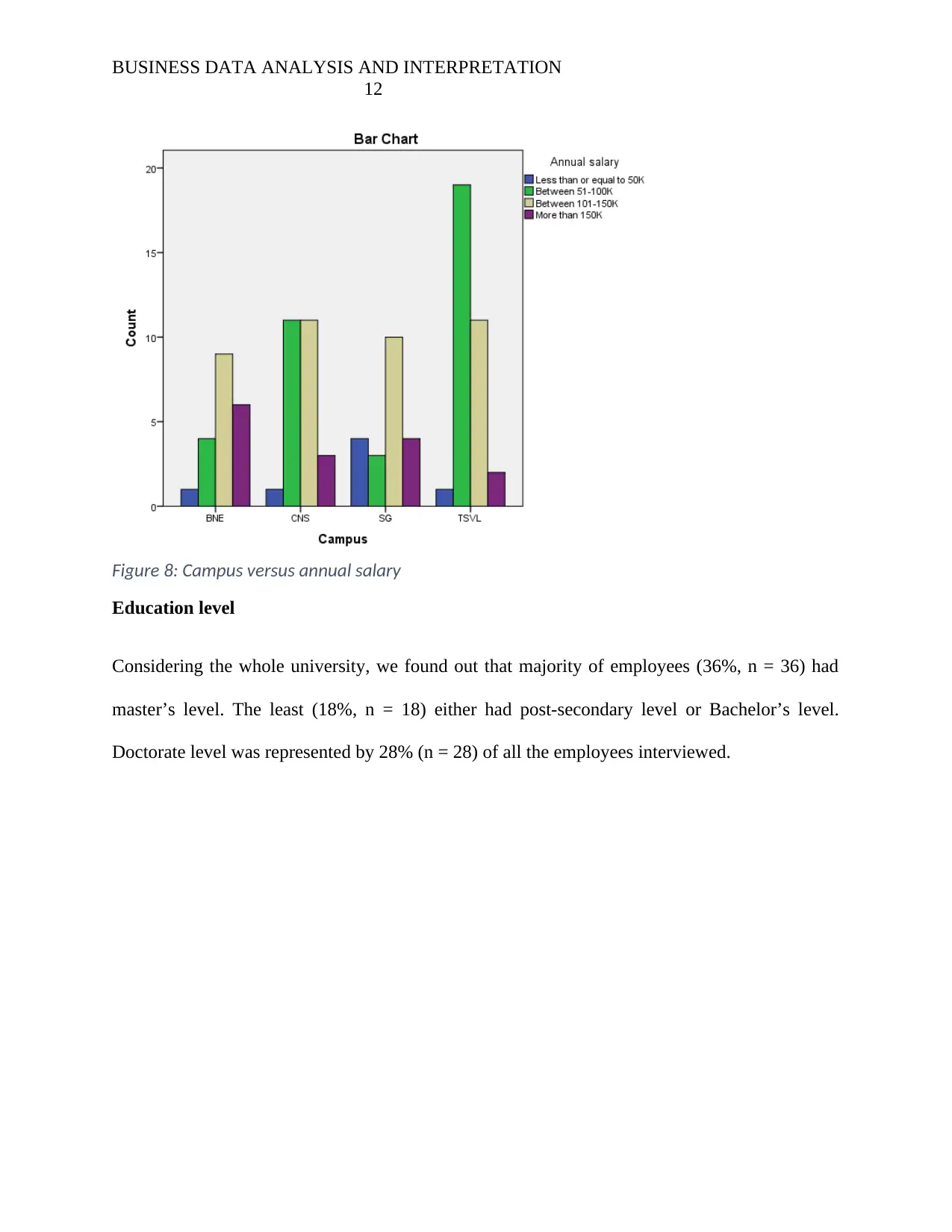
BUSINESS DATA ANALYSIS AND INTERPRETATION
12
Figure 8: Campus versus annual salary
Education level
Considering the whole university, we found out that majority of employees (36%, n = 36) had
master’s level. The least (18%, n = 18) either had post-secondary level or Bachelor’s level.
Doctorate level was represented by 28% (n = 28) of all the employees interviewed.
12
Figure 8: Campus versus annual salary
Education level
Considering the whole university, we found out that majority of employees (36%, n = 36) had
master’s level. The least (18%, n = 18) either had post-secondary level or Bachelor’s level.
Doctorate level was represented by 28% (n = 28) of all the employees interviewed.
⊘ This is a preview!⊘
Do you want full access?
Subscribe today to unlock all pages.

Trusted by 1+ million students worldwide
1 out of 16
Your All-in-One AI-Powered Toolkit for Academic Success.
+13062052269
info@desklib.com
Available 24*7 on WhatsApp / Email
![[object Object]](/_next/static/media/star-bottom.7253800d.svg)
Unlock your academic potential
Copyright © 2020–2025 A2Z Services. All Rights Reserved. Developed and managed by ZUCOL.


